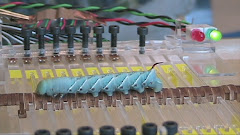I've been away for three weeks in Europe for the Society for Experimental Biology annual meeting and several academic visits . I met quite a few cool people on the road and in meetings. Here I would only highlight a few topics that I found relevant to my current research theme.
At the SEB conference, there were a significant number of people involved with the EU project "Locomorph". I found this new term intriguing. It has been widely recognized that morphology plays a key role in locomotion, and many studies have focused on how the default body configuration function and coordinate to produce desirable kinematics. Well, this project combines "locomotion" and "morphing" into a word so to emphasize the effects of "changing" body morphologies during locomotion. For soft-bodied animals, morphing can be a means to locomotion, but that is the extreme case I'm currently concerned with. For most skeletal systems, coping with a changing morphology is a process of adaptation, and it is this very strategy that biologists and roboticists are interested in. To find out more about this huge collaborative project, see the project website. It sounds awful lot like a DARPA project in the US. I wish good health and good progress to all the people who are involved.
My visit to the EPFL in Switzerland was quite an experience. I heard so many things about it even since I started following robotics stuffs. That's when I was still a teenager. It's quite amazing that I actually get to visit and actually gave a talk about my work. Again, I won't even attempt to summarize people's research, in case I don't do a good job. But one recurring concept in many robotic efforts was localized intelligence and the emergent properties. Indeed, intelligence does not have to live in a central processing unit. Localized simple logic goes a long way when certain information sharing occur between the functional nodes. This can be seen at the sensory reflex level such as the optical flow control drones, or on the coordination level as in the salamander robot's coupled oscillators, or at the navigation level where swarms of MAVs create a communication network. In a way, I think this is how intelligence arise in any systems. Even our complex brain employ millions of neurons to generate a gross computation. Each single neuron has its own logic depending on the excitability and pre-conditioning. To exchange information, neurons rely on the varied synapses which can be modulated dynamically as well. In fact, I would go so far to say that all forms of intelligence are emergent properties of certain collection of simple logic units. This subject is indeed fascinating and I think using robots is often a more efficient way to study it. Browse their website to find out more.
U. Jena Lauflabor is known for the development of the SLIP (Spring Loaded Inverted Pendulum) model for biped locomotion. More specifically, this group of physicists attempt to find dynamic stability in a open-loop control scenario. In contrast to the reflex model for locomotion as employed in many traditional robots, researchers at Jena really investigate how inherent walk-run mechanics and leg properties can produce stability. Implementing robots from these simulations may lead to much more elegant solutions to legged locomotion, far from the reflex control as demonstrated by Boston Dynamics' "Big Dog" (which is very impressive, but not very smart). Their goal is actually similar to my soft-bodied robotic trials, except that our subjects are really quite distinct.
In any case, these are only three things that seem the most relevant to my current research goals. The field of biomechanics is really growing bigger each year and the use of robots has become a standard procedure now (for one purpose or the other).
Subscribe to:
Post Comments (Atom)

.jpg)
No comments:
Post a Comment